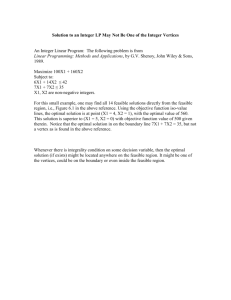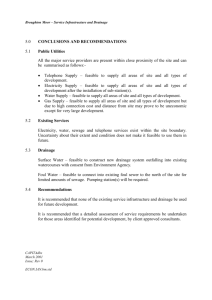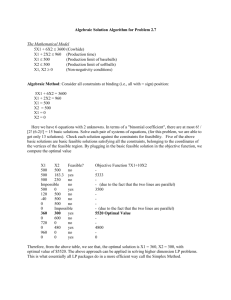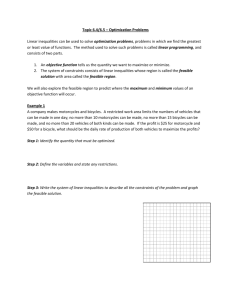A Networking-based View of Business Model Innovation
advertisement
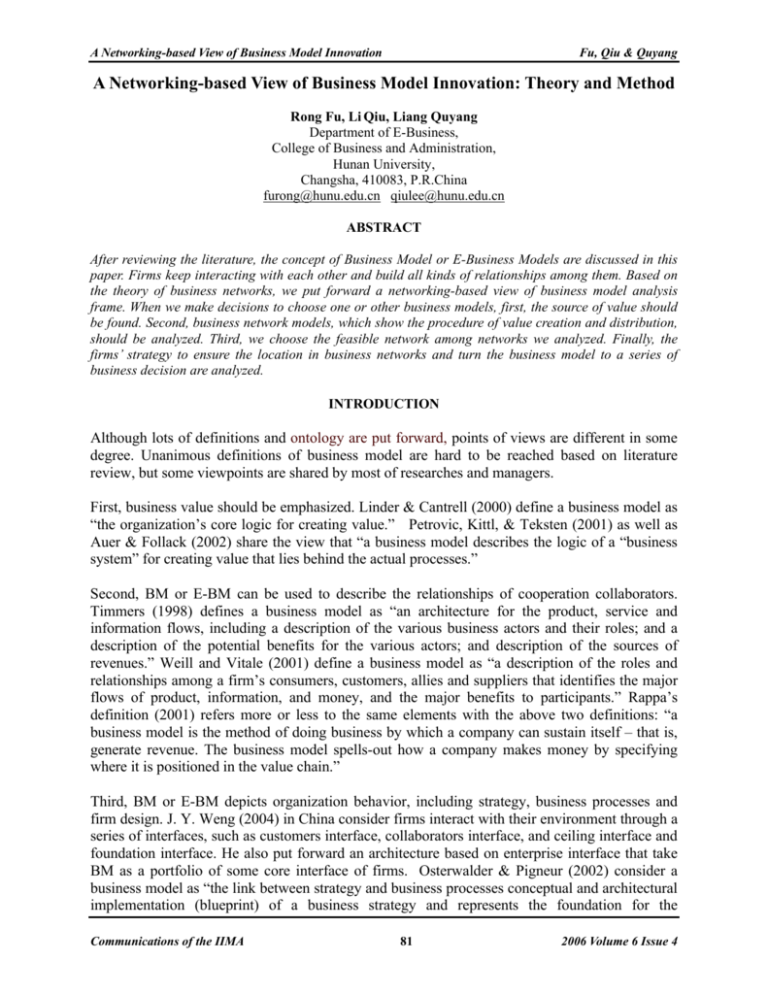
A Networking-based View of Business Model Innovation Fu, Qiu & Quyang A Networking-based View of Business Model Innovation: Theory and Method Rong Fu, Li Qiu, Liang Quyang Department of E-Business, College of Business and Administration, Hunan University, Changsha, 410083, P.R.China furong@hunu.edu.cn qiulee@hunu.edu.cn ABSTRACT After reviewing the literature, the concept of Business Model or E-Business Models are discussed in this paper. Firms keep interacting with each other and build all kinds of relationships among them. Based on the theory of business networks, we put forward a networking-based view of business model analysis frame. When we make decisions to choose one or other business models, first, the source of value should be found. Second, business network models, which show the procedure of value creation and distribution, should be analyzed. Third, we choose the feasible network among networks we analyzed. Finally, the firms’ strategy to ensure the location in business networks and turn the business model to a series of business decision are analyzed. INTRODUCTION Although lots of definitions and ontology are put forward, points of views are different in some degree. Unanimous definitions of business model are hard to be reached based on literature review, but some viewpoints are shared by most of researches and managers. First, business value should be emphasized. Linder & Cantrell (2000) define a business model as “the organization’s core logic for creating value.” Petrovic, Kittl, & Teksten (2001) as well as Auer & Follack (2002) share the view that “a business model describes the logic of a “business system” for creating value that lies behind the actual processes.” Second, BM or E-BM can be used to describe the relationships of cooperation collaborators. Timmers (1998) defines a business model as “an architecture for the product, service and information flows, including a description of the various business actors and their roles; and a description of the potential benefits for the various actors; and description of the sources of revenues.” Weill and Vitale (2001) define a business model as “a description of the roles and relationships among a firm’s consumers, customers, allies and suppliers that identifies the major flows of product, information, and money, and the major benefits to participants.” Rappa’s definition (2001) refers more or less to the same elements with the above two definitions: “a business model is the method of doing business by which a company can sustain itself – that is, generate revenue. The business model spells-out how a company makes money by specifying where it is positioned in the value chain.” Third, BM or E-BM depicts organization behavior, including strategy, business processes and firm design. J. Y. Weng (2004) in China consider firms interact with their environment through a series of interfaces, such as customers interface, collaborators interface, and ceiling interface and foundation interface. He also put forward an architecture based on enterprise interface that take BM as a portfolio of some core interface of firms. Osterwalder & Pigneur (2002) consider a business model as “the link between strategy and business processes conceptual and architectural implementation (blueprint) of a business strategy and represents the foundation for the Communications of the IIMA 81 2006 Volume 6 Issue 4 A Networking-based View of Business Model Innovation Fu, Qiu & Quyang implementation of business processes and information systems”. INTRODUCTION OF NTEWORK-BASED BUSINESS MODEL ANALYSIS Principle of Network-based Business Model Analysis First, not only the benefits of individual firms should be considered, but also the entire network should be taken into consideration when we design and choose a BM. It is the same with the principle of supply-chain, for each member company, the individual benefit must give priority to the network benefit in some degree. The supply chains, which connect with each other by all kinds of means, work together and share the ultimate benefit of the supply chain. Second, all kinds of complicated relationship in the network cannot be neglected when we are designing and choosing the BM. The concept that the relationship of the BM as the literature mentioned is not so perfect because the relationships among participants are frequently changed, non-linear. Network is complicated because of the complication of the relationships. The situation of dynamic and complicated network makes hard to design and choose a BM, but it also makes designing and choosing BM significant. Third, to design or choose a BM is to deploy the resources that the company owes, and make them work well with the environment, and get the benefit derived from collaboration and complementarily of resources between companies. The boundary of the company should not be the boundary of a BM when necessary. The resources and their combination forms keep on changing. To achieve the total value of a network in which the company involved and keep steady, BM-designing should make t the position of the participant companies clear, and make full use of the network externality and capability of participants. Then the inter-organizational network and the networked internal organization work together and form a mature valueproducing network. The Procedure of the Analysis of Network-based Business Model The essential of Networking-based view of Business Model Analysis is to think out a certain form of Business Network and make the position of participant clear. The basic steps are as follows: (1) Confirm value object. (2) Construct or analyze the network that aim at a certain value. (3) Choose the feasible network on the basis of analyzing internal condition and intercompany relationship. (4) Choose a series of strategy to carry out the BM. The following flow-chart demonstrate the whole process and make an analogy between analysis of BM and common procedure of problem settle. Communications of the IIMA 82 2006 Volume 6 Issue 4 A Networking-based View of Business Model Innovation Value Value Achieved Networks Feasible Network Solution Space Business Model analogy analogy Problem Fu, Qiu & Quyang Feasible Solution region Feasible Solution Figure 1: Procedure of Network-based innovation BM Illumination of the Procedure As the figure 1 showed, Networking-based view of Business Model Analysis involves a series of processes, such as value analysis, network modeling, feasible network restriction analysis and strategy choosing. Those process still can be broken down. The process of value analysis and strategy choosing have already been researched in management. The process of network modeling, and feasible network restriction analysis are the typical issues of Networking-based view of Business Model Analysis. Analysis of Networks’ Value In the whole view of the analysis, the value is just for the entire network, so it is simpler than analysis of value position of a certain company, in another word, it is a business opportunity analysis. Two kinds of value are equally considered in the BM designing, one is the new value resulted from technical advancement, the other is traditional value which is exist but transformed because of IT advancement. It is obviously that the new value comes form the new BM, but it is also true that with the reforming of the BM, the traditional value brings value increasing, or it change the value distribution between participant in the network. Network modeling Network modeling will demonstrate the details of value producing in forms of network. In this way and make it possible to find out the network that can produce value and analyze it. The traditional brain-storm can used to find idea for creating BM that cater to new value forms, by supposing that the BM research process is infinite and creative. When it comes to the traditional value, it generally to analyzing the existent business network to optimize it. There are little company that directly offer value to customer, so we can find the related value offering network. Comprehension of business activity, business regulation and creativity is the key of network modeling. Some traditional corporation modeling instruments including UML, PETRI network, and some instruments especially for BM or EBM, such as Value Map which Tapscott (2000) used to demonstrate how does the BM run or operate, make the network modeling convenient. Weill&Vitale (2001) worked out a graphology to analyze EBM, especially to transit traditional Communications of the IIMA 83 2006 Volume 6 Issue 4 A Networking-based View of Business Model Innovation Fu, Qiu & Quyang BM to EBM. It focus on three elements: participant (enterprises, customers, suppoliers, union), relationship (all kinds of electronic relationship or non-electronic relationship), flows (including capital flow, information flow, product and service flow). Gordijin (2001) bring forward a business modeling system called e3-value. It is a model including all the actor reflected the core of EB, consist of actor, value interface, market segment, AND fork, value object, scenario segment, value exchange, value port, end stimulus and so on, as the following figure 2 shows. Figure 2: A Case of e Value Model Network Restriction Analysis According what discussed above, there may exist more than one network that can supply the same value. Whether all these network are feasible? In fact, some network is useless or is not as good as another. Network restriction analysis is to check out the network that the network possess the certain character according to the regulated restriction from the theory of business analysis. The restriction including stability and efficiency restriction as follows: Stability restriction: (1)Customer Occurrence Stability; (2)Structure stability: The relationship among participants alternate from integration to separation which makes the structure of the network turbulent. A feasible network must, first of all, possess the stability of the structure. (3)Environment stability: make sure the environment keep steady in a certain time in which the analysis are taken on. (4)dynamic stability: The operating regulation of the feasible network should be stable as possible. Efficiency restriction is that the network can make sure the entire participant have operation efficiency. According to the research of Jacksom and Wolinsky (1996), Bala and Goyal (2000) and Watts(2001), in network efficiency the sum of the utility of participants can be maximized. On the other hand, the Pareto efficiency is used to describe that a network is the best one among all kinds of networks in which not all participant can get more benefit. Strategy Choosing The previous process results in a series of feasible business network that possess stability and Communications of the IIMA 84 2006 Volume 6 Issue 4 A Networking-based View of Business Model Innovation Fu, Qiu & Quyang efficiency. The feasible networks, which are defined as BM on industry level, can be chose by every firm which takes the network’s value as their Niche. The firms have to choose the best BM suited to their own resource and situation, and their position in the network.. The strategy can make sure that the firm can keep their position in the network and get the benefit. So, a certain BM is decided as the following formulation: BM=The feasible network + strategy When it comes to choosing the suitable BM, they should analyze the network together with their inside and exterior environment, such as infrastructure condition, political and law, cultural and custom and so on. For a firm, we should emphasize on analyzing the enterprise resources to determine which feasible network is the best one. Enterprise Resource, which can create persistent competitive advantage, but not belongs to the enterprise forever, is the essential factor in operation. The value of a specific resource depends on the value that the combination of the network and the resource can achieve. So we can say that it is the resources that decided the position of a firm in the specific network. From the exterior of a firm, the relationship among participants, especially the position in a game structure, should be taken into consideration. The capital flow is fluctuate with the unbalance of Bargain Power between participants. For example, generally speaking, the ICP should pay to ISP, but sometimes the ICP will be paid if it’s bargain power is huge enough.. Enterprise strategy choosing also include how to make use of resources and the position to keep the persistent advantage and settle enter-obstacle for new comers. CONCLUSION With the development of IT, and globalization, the relationship among participants are more and more close. Accordingly more attention was pay to the inter-firm networks. Along with the study on inter-firm networks and industrial cluster,not only the significance of the characteristic enterprise but also the characteristic network is recognized. Both of the SCM and the CRM aim at enhance the ability to participate network and strengthen the competitive advantage. Design of firms and BM innovation is not only change the behavior of firms, but also re-construct the network. It is very important to have network base view when study the BM. Now, the environment keeps on changing, new BM emerges in endlessly, Network-based view of Business Model Analysis give us a new way to research the BM. Communications of the IIMA 85 2006 Volume 6 Issue 4 A Networking-based View of Business Model Innovation Fu, Qiu & Quyang REFERENCES Auer, C. and Follack, M. (2002), “Using action research for gaining competitive advantage out of the internet’s impact on existing business models”, in Loebbecke, C., Wigard, R.T., Gricar, J., Pucihar, A. and Lenart, G. (Eds), Proceedings of the 15th Bled Electronic Commerce Conference – e-Reality: Constructing the eEconomy, Vol. 1: Research, Bled, 17-19 June, pp. 767-84. Linder, J.C. and Cantrell, S. (2000), Changing Business Models: Surveying the Landscape Accenture Institute for Strategic Change. www.accenture.com/NR/rdonlyres/0DE8F2BE-5522-414C8E1B-E19CF86D6CBC/0/Surveying_the_Landscape_WP.pdf. Osterwalder, A. and Pigneur, Y. (2002), “An ebusiness model ontology for modeling ebusiness”, in Loebbecke, C., Wigard, R.T., Gricar, J., Pucihar, A. and Lenart, G. (Eds), Proceedings of the 15th Bled Electronic Commerce Conference – e-Reality: Constructing the eEconomy, Vol. 1: Research, Bled, 17-19 June, pp. 75-91. Petrovic, O., Kittl, C. and Teksten, R.D. (2001), “Developing business models for eBusiness”, Proceedings of the International Conference on Electronic Commerce, Vienna, 31 October- 4 November, available at: www.evolaris.net/index_en.php/article/articleview/356/1/59/. Rappa M. (2001), Business Models on the http://ecommerce.ncsu.edu/topics/models/models_text.html. Web, Timmers P, (1998), Business Models for Electronic Markets, www.electronicmarkets.org/netacademy/publications.nsf/all_pk/949. (Online). (Online). Available: Available: Weill, P. and Vitale, M.R. (2001), Place to Space: Migrating to eBusiness Models, Harvard Business School Press, Boston, MA. Communications of the IIMA 86 2006 Volume 6 Issue 4



